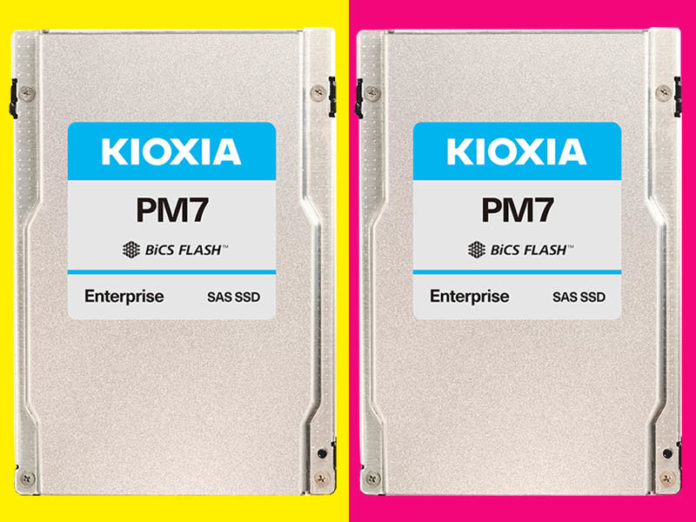Do you think that just because NVMe is faster and has lower latency that SAS is done? Certainly not. There is a new 24G SAS4 standard making its way into servers and Kioxia is ahead of the curve with a new SSD. The Kioxia PM7 is a 24G SAS4 SSD designed for servers and storage arrays.
Kioxia PM7 24G SAS4 SSDs Launched
The new Kioxia PM7 SSDs not only feature the new 24G SAS4 interface, doubling interface performance, but they also have a number of new features. We get BiCS 3D TLC NAND (5th gen) along with Kioxia’s Flash Die Failure Protection to protect data even if an entire die fails. In terms of reliability, there are both 1 and 3 DWPD options, much higher than what we are seeing even on modern “Pro” hard drives.
Kioxia claims sequential read performance of up 4.2GB/s. Between SAS4 and NVMe, SATA is basically obsolete in servers, except maybe for boot devices. We also get up to 720K / 355K random read/ write IOPS.
Capacities go up to 30.72TB, so these 2.5″ SSDs now have significantly more capacity than 3.5″ hard drives while also having more performance. Since these are enterprise SAS, we get dual-port SAS for high-availability storage arrays as well.
Final Words
Most of the servers we review these days have NVMe SSDs. At the same time, there are so many legacy storage arrays and storage vendors that SAS is still popular. In addition to that, SAS4 brings more speed and easily mixes with SAS hard drives making it an interesting proposition. We have a feeling that drives like the Kioxia CD7 PCIe Gen5 NVMe SSDs are going to be more popular with our readers, but as we get the new 24G SAS generation, many will also need those drives as well. That is exactly where the Kioxia PM7 will fit in.




Legacy SAS boxes won’t benefit from doubling the interface speed though. I can’t think of a metric where SAS beats NVMe except angular momentum.
Two problems with SAS4- SSDs instead of NVMe – SSDs:
SAS Devices delivers data through a controller device.
1. if you install let’s say 16 pieces SAS4-SSD’s at your SAS-Controller, all data from 16 SSDs have to run through the one controller and the controller becomes the bottleneck
2. NVMe is a basically a PCIe-protocol, no controller is necessary, no command- or data conversion is necessary and these brings very short latency and speed which even a SAS4 device could not deliver
Broadcom will accidentally kill off SAS if they do not do something about their ludicrous chipset pricing strategy. It needs to now refocus itself as secondary to NVME and act like a more affordable smaller brother in the enterprise world. Hardware controllers isn’t a thing of the past, offloading is a very big thing these days, and Broadcom have an opportunity to define a great future for SAS technology, however their price strategy must come in at an attractive value.
Glad to see Kioxia keeping ahead of the curve in the world of storage, well done.